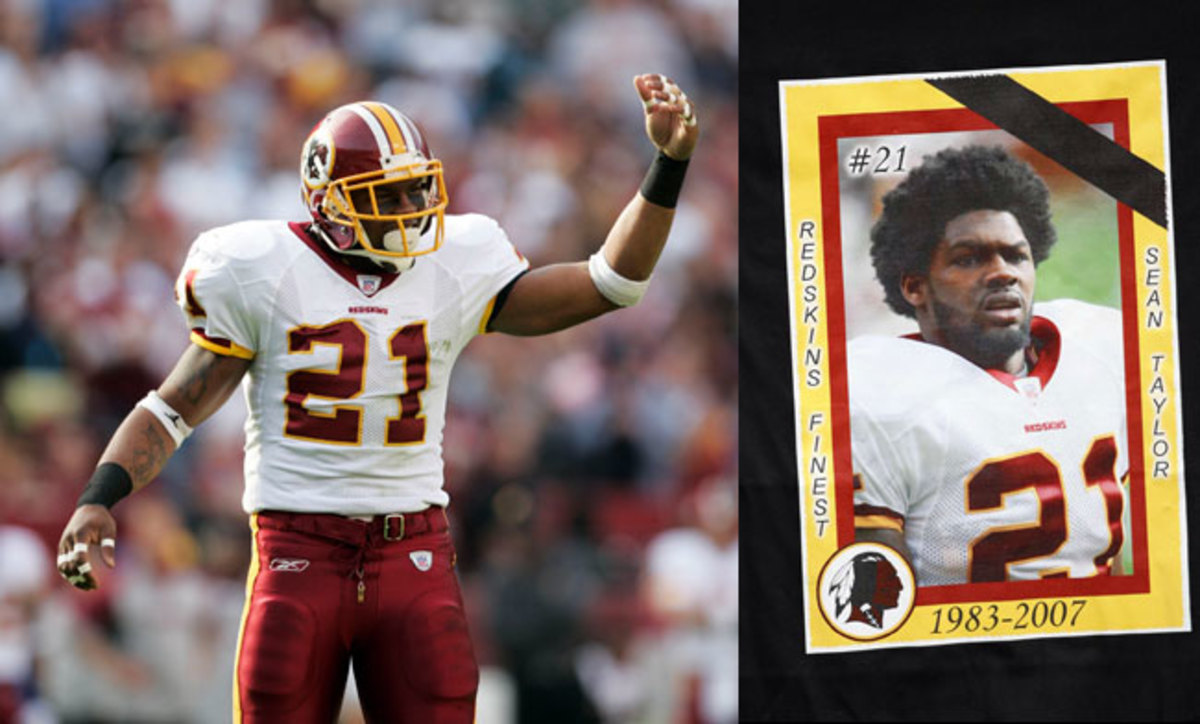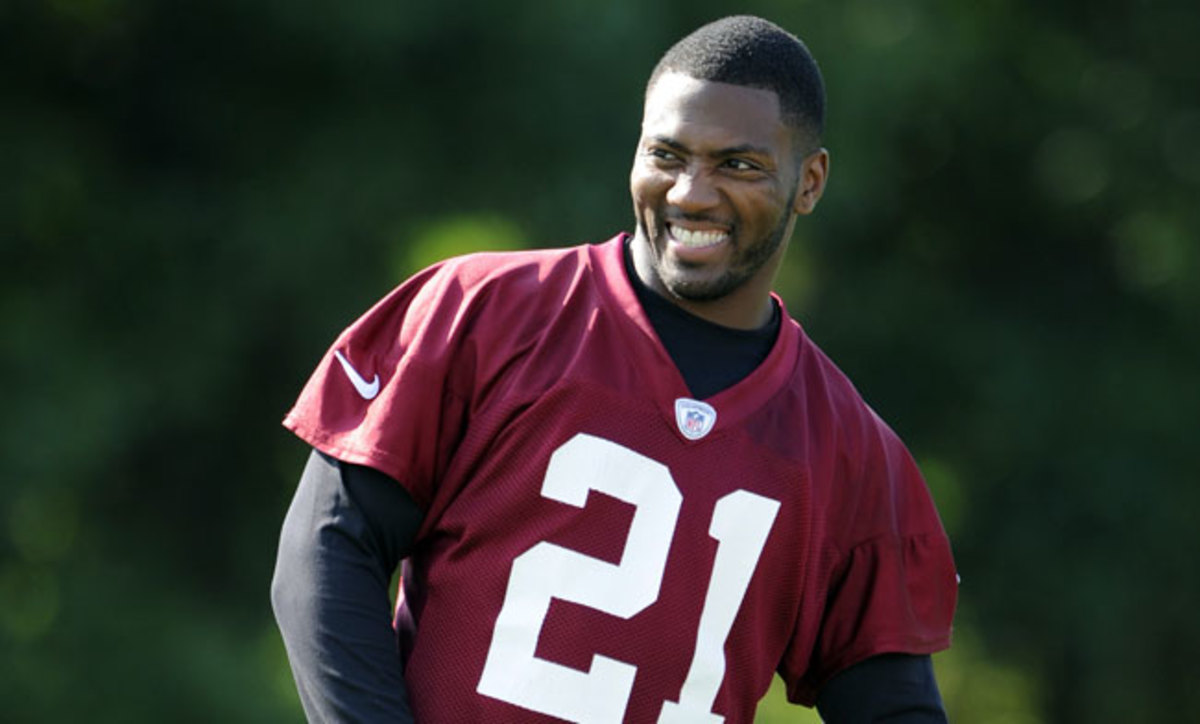The Legacy of No. 21

RICHMOND, Va. — It’s an unofficial rite of passage for Washington’s newest starting free safety. You finish your first practice in the oppressive humidity of late July, and then you sign autographs for the throngs of fans who attended the first day of training camp.
All is going well—until an energetic fan in a No. 21 jersey hands you a sharpie. Suddenly you’re faced with an existential dilemma:
Can I sign this jersey and respect myself in the morning?
“I’m like, ‘Why you doin’ that?’ ” says Dashon Goldson, who came over from Tampa Bay in an April trade. “I feel weird about that. That’s Sean Taylor.”
The relationship between this team, its fans, and its deceased star is one of the most unique in sports. Taylor was 24 when a group of young men broke into his residence in Palmetto Bay, Fla., in November 2007, to burglarize the home. They brought a pistol and encountered a machete-wielding pro football player who was trying to protect his girlfriend and 18-month-old daughter. Eric Rivera Jr., of Fort Myers, Fla., then 17, is now imprisoned in Florida, having been convicted of second-degree murder and armed robbery as the triggerman.

In life, Taylor was the kind of safety who was going extinct in the NFL: an intimidating headhunter. He was a 6-2, 220-pound track star who had the mentality of Jack “The Assassin” Tatum, the hands of a wide receiver and the range of an all-star centerfielder. The only limit to his potential, it seemed, was the occasional lapse when his unrelenting aggression got the best of him. Taylor’s most-viewed standalone highlight on YouTube shows him flying downhill to destroy miniscule punter Brian Moorman on a fake punt … in the Pro Bowl.
“He just didn’t let up at any time. In the Pro Bowl some guys don’t really play their hardest. They don’t want to get hit,” says Goldson, himself a two-time Pro Bowler during his first eight seasons in the NFL, with the 49ers and Bucs. “But s---, he was out there playing full-go.
“I’m no Sean Taylor, but I do have the mentality of knocking somebody’s head off. I just want to put that sort of thing on film. Because when you do stuff like that, people have to game-plan around you. They’re thinking, Watch out for No. 38, because he can hit. Getting in somebody’s head—the presence of being a safety is a mindset. Sean was that mindset.”
In death, Taylor takes on an enhanced aura with each passing year, as the game drifts farther away from the style he once played. To today’s NFL players, he represents a bygone era in which strikes to the helmet earned you a spot on the highlight reel, not a suspension or a fine. Yet young safeties all aspire to match his relentlessness. “He could’ve been the greatest to ever play the game,” says Ryan Clark, who played his third and fourth seasons with Taylor in Washington.
As loud as his play spoke, Taylor’s thoughts were often a mystery to the public. He spoke quietly in the media, if at all, and largely avoided the press after run-ins with the law, including arrests for DUI and aggravated assault in 2004 and 2005. The backlash against those who initially suggested that Taylor’s death was a product of his contentious past united Washington fans. And last year, an NFL Films’ documentary on Taylor’s life shed more light on a young man who was beloved by many around the league, burnishing a legacy that still impacts the team.
The evidence was all around the practice facility in Richmond, where on the second day of training camp Taylor’s No. 21 and No. 36 jerseys (his rookie number) outnumbered all other Washington players’—active or retired—with the exception of Robert Griffin III.
“Fans say, ‘Make sure you live up to the hype of Sean Taylor,’ ” Goldson says. “For me to be mentioned in his name speaks volumes, but I’m no Sean Taylor.”
One fan, Mike Hans of Atlanta, bought his son a white No. 21 jersey shortly after Taylor’s passing.
“The respect doesn’t necessarily start with the fans; it starts with the players,” Hans said on the practice sideline. “All those guys look up to him—anybody who’s a safety. That tells me he’s the crème de la crème. He’s the one who set the bar.”
And that bar has been the first obstacle for any hard-hitting safety who gets pegged as a starter in Washington.
After eight years in Pittsburgh, Clark returned to Washington for one final season in 2014. As a tribute to his friend, he wore Taylor’s No. 21 jersey during practices.
“It’s not a matter of being compared to Sean, because you can’t compare yourself to what Sean could’ve accomplished,” Clark says. “It’s the same way that rappers are compared to Tupac. Was it because he was amazing? Yes. But it’s also because he passed in his prime … when you don’t fulfill a destiny that was so promising, people feel like the next player needs to fulfill that.”

Rare is the day when Goldson checks his Twitter mentions and doesn’t see a link to a Taylor highlight or a note from a fan about the man who wore No. 21. He estimates he’s heard or read Taylor’s name at least 100 times since the team acquired him from Tampa Bay in early April for a sixth-round pick.
“Fans say, ‘Make sure you live up to the hype of Sean Taylor,’ ” Goldson says. “I get it. He was a hell of a player. For me to be mentioned in his name speaks volumes, but I’m no Sean Taylor.”
But there was Dashon Goldson after his first day of training camp, hemming and hawing as a fan pleaded for him to sign a Sean Taylor jersey. He thought about it for what seemed like an eternity. Then he picked up the pen and put ink to the white numbers of the blue NFC Pro Bowl jersey trimmed in red.
Clark remembers facing this dilemma when he returned to Washington last season.
“At first it was weird, because I feel like those things should never be touched or signed by anyone,” he says. “I would always say, ‘You don’t need me on there.’ I always made sure to have a conversation about it first, so I could tell if their heart was in the right place. After a while, it started to feel like an honor to do it.”
• Questions or comments? Email us at talkback@themmqb.com.
